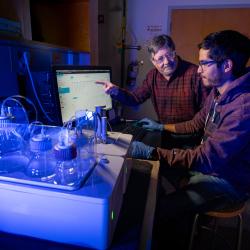University of Maryland Scientists Contribute to Federal Climate Science Report
UMD climate model contributes to key finding, UMD Professor serves as review editor
Three University of Maryland scientists contributed to the new Climate Science Special Report (CSSR)—the most comprehensive look at climate science and its effects to date. The U.S. Global Change Research Program, a consortium of 13 federal agencies and a 60-member federal steering committee, released the report on November 3, 2017.
UMD Professor Ross Salawitch, a world-renowned expert on the effect of human activity on Earth’s atmosphere, served as one of the report’s three review editors. Salawitch has appointments in the UMD Department of Atmospheric and Oceanic Science, Department of Chemistry and Biochemistry, and the Earth System Science Interdisciplinary Center.
In addition, Salawitch and UMD Department of Atmospheric and Oceanic Science Associate Research Professor Timothy Canty and graduate student Austin Hope contributed to one of the key findings of the report. Their research shows that human activities, especially emissions of greenhouse gases, are the dominant cause of the observed warming since the mid-20th century.
“Using a scientific approach, we can separate climate change induced by humans from climate variations caused by environmental factors like the sun, volcanoes and El Niño events,” said Salawitch. “Our quantitative results reaffirm that human release of greenhouse gases is responsible for the vast majority of global warming that has been observed over the past century. There is no alternative explanation supported by the extensive observational record.”
Salawitch and Canty published their empirical model of global climate used in the CSSR in 2013 in the journal Atmospheric Chemistry and Physics.
Earlier this year, Salawitch, Canty, Hope and two other UMD scientists used their model to comprehensively analyze the 2015 Paris Climate Agreement, which seeks to limit global warming to a maximum of 2 degrees Celsius above pre-industrial temperatures.
They published their results in the 2017 book Paris Climate Agreement: Beacon of Hope, which describes the transition to renewable energy that will be needed to avoid climate catastrophe. Their results suggest that if countries achieve the greenhouse gas reductions pledged during the Paris meeting, there is a good chance that the world will be able to limit warming to 2 degrees Celsius.
In his role as CSSR review editor, Salawitch managed the response to hundreds of reviews of the report’s first five chapters, which cover topics such as physical drivers of climate change and the detection and attribution of climate change. The reviews were submitted during a public comment period as well as a formal review conducted by the National Academy of Sciences.
“Our focus was on scientific clarity and inclusion of all new studies mentioned in the review process,” Salawitch said. “We maintained rigorous records of the review comments as well as how the report changed in response to these comments.”
The CSSR is part one of the Fourth National Climate Assessment (NCA4), a required quadrennial assessment authorized in 1989 by Congress in the Global Change Research Act (GCRA) of 1990. The report focuses on the United States and aims to serve as the foundation for efforts to assess climate-related risks and inform decision-making about responses.
###
The paper, “An empirical model of global climate–Part 1: A critical evaluation of volcanic cooling,” T. Canty, N.R. Mascioli, M.D. Smarte, and R. J. Salawitch, was published in Atmospheric Chemistry and Physics in 2013.
The book, Paris Climate Agreement: Beacon of Hope, Ross Salawitch, Timothy Canty, Austin Hope, Walter Tribett and Brian Bennett, was published by Springer Climate in January 2017.







